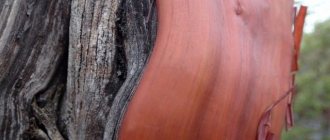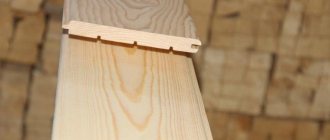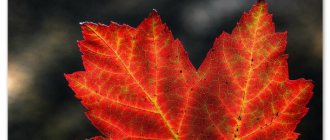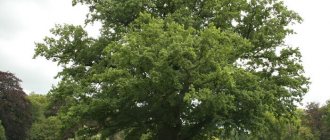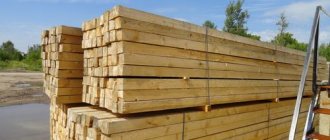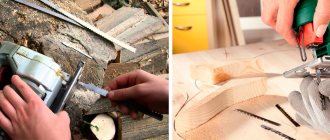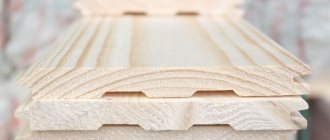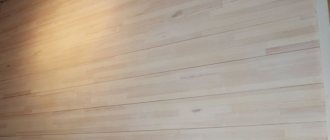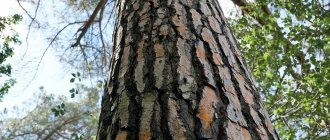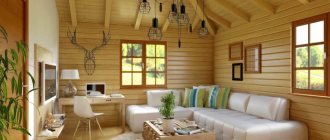Lining is very popular among people professionally involved in interior decoration. The fact is that this material is able to emphasize the natural beauty of the interior, filling any room with a unique atmosphere of home warmth and comfort. In addition to its attractive appearance, lining has other objective advantages:
- resistance to mechanical damage;
- low cost compared to other materials;
- excellent thermal insulation properties;
- easy maintenance throughout its service life.
Today, different types of lining are presented on the domestic lumber market. They differ in a number of technical characteristics. In this article we will tell you how you can choose the best option, taking into account the characteristics of a particular variety. We hope that this information will be useful to everyone who plans to use lining for cladding premises.
Features of different types of wooden lining
The production of lining includes several main stages:
- first, edged boards are made from natural wood of different species;
- then technical drying is performed, which is necessary to reduce the humidity level;
- At the next stage, the grooves are cut and the outer surface is processed.
Only after these stages is the material sorted. During this procedure, special attention is paid to the presence of any significant deficiencies that could shorten the service life of the lining. We are talking about knots, resin pockets, cracks, chips and other defects. In this case, these damages can be natural, as they appear during the growth of the tree, or can be obtained as a result of mechanical processing of the raw materials.
According to state standards existing in our country, all types and varieties of lining are divided into several classes:
- “Extra” class is the highest grade in terms of quality, aesthetic and performance characteristics;
- class “A” is “Premium” or the first grade with a minimum number of defects;
- class “B” is the second grade, which may have visible and significant defects;
- class “C” is the third grade of the lowest quality, as it has a large number of defects.
Let us dwell in more detail on the advantages and disadvantages of each type of lining, and also consider the advisability of its use as a finishing material.
Class B
Manufacturers still apply the term “2nd grade” to it. Such lumber is characterized by the presence of significant and visible defects. For example, on boards after factory processing, it is permissible to have unedged edges (in the locking area), which does not at all affect the appearance of the finished work.
Knots, resin pockets, core and even blue can also be visible (its volume should not exceed 10% of the total area). There is likely the presence of slight rot (up to 10%) and wormholes (up to 3 units per linear meter). The permissible size of cracks, potholes, dents and chips is no more than 3 cm per linear meter of surface. At the same time, their exit to the end part is excluded.
Finishing the premises with class B clapboard
To eliminate obvious defects, the defects are grouted and painted with specially designed compounds. For this purpose, use plain or dark-colored products.
This class of sawmill products is the most budget-friendly and popular. Available to a wide range of consumers. Most often used for interior decoration of all types of premises, including utility rooms.
“Extra” grade lining
This type of lining is characterized by the absence of any defects. This material has a perfectly smooth surface with no knots, chips or cracks. Moreover, all boards are equipped with a special fastening system. This is done so as not to disturb the beautiful pattern and original structure of the wood. Thanks to this, installation time is significantly reduced. For example, you can completely cover the walls of a private house in just a few hours.
Key features of this lining:
- Possibility of use in rooms with high humidity;
- complete absence of natural resins in the composition of wood;
- pleasant and fresh aroma that persists during use;
- ease of daily care when dirty.
It is worth noting separately that, if necessary, this lining can be protected from aggressive environmental influences using additional treatment with special compounds. As a rule, a water-based antiseptic is used for this. As a result of this treatment, the tree receives reliable protection from the appearance of harmful bacteria.
The main disadvantage of this lining is the fairly high cost. That is why it is not suitable for finishing any office or utility rooms. It is best used as a facing material for finishing residential premises located in a private house. In this case, the high price will be fully justified.
What is a lining
Lining is a long planed board. It has a groove and a tongue for installation. The material is environmentally friendly because it is made of wood. The characteristics are close to those of wood: durability, ease of installation, high-quality sound insulation.
Lining is used for finishing internal and external walls and ceilings. In addition, it can be used to build terraces, gazebos, and bathhouses. Thanks to its good sound absorption, it is even used to cover the walls of movie theaters.
Currently, there are several types of lining:
- Regular (also called “eurolining”) has special grooves on its surface, which are necessary for ventilation.
- American - resembles a wooden beam. This type is attached only in the horizontal direction. Usually used for exterior decoration of buildings.
- Block house - imitates a round beam.
1st grade or “Premium”
Premium grade lining may have individual knots (no more than one per 1.5 m²). In addition, two resin pockets and one small crack are acceptable on the surface. Therefore, before installation, the surface of the lining must be treated not only with protective compounds, but also with a special putty. This will help secure areas in the immediate vicinity of a knot or crack. If these places are at the very end of the board, then they are most often cut using a hand-held circular saw or an electric jigsaw.
Important advantages of this lining:
- defects occupy a small percentage of the total volume of the board;
- resistance to rotting and exposure to microorganisms;
- attractive price accessible to many domestic consumers;
- Possibility of removing contaminants using a soap solution.
Finishing with clapboard of this type has a number of features. Most often it is used for cladding large rooms with complex geometry. In this case, it is combined with a higher grade in order to sew up planes that are not very noticeable. For example, expensive lining is used for cladding the main plane of the wall, and the “Premium” grade is used for cladding some individual fragments that are located behind the radiator or behind pieces of furniture. In addition, many craftsmen coat this type of lining with matte paint when decorating interior spaces using contrasting colors. This helps to avoid difficulties with installation and adjustment, even in those places that are in the most visible place.
Material classification
Lining is produced in various shapes, sizes, and sections.
Depending on this, the types are distinguished:
- Standard . The base base has a cross-section in the shape of an angled trapezoid with grooves on the reverse side. It is connected using a tongue-and-groove type.
- Eurolining. Features a wider spike for secure fastening. After installation on the plane, the longitudinal recesses are visible.
- Calm. The type of lining has rounded corners, otherwise this type has no difference from the Standard.
- Softline. It is considered a premium category for home decoration. The edges of the strips are smoothly rounded, so the surface is almost perfectly flat.
American is used to create a herringbone effect on the facade. The lamellas are distinguished by a non-parallel arrangement of the outer and inner sides, so each cladding board is installed at a slight angle.
Extra
The grade includes panels on the plane of which no defects have been identified on both sides.
This type is difficult to produce, despite the high cost:
- it is easier to cut the necessary pieces of material from oak or pine trunks, since the species are not prone to the formation of knots and rotting;
- spruce and birch are used less frequently - the required length dimensions are difficult to select on logs that are replete with knots, hence the increased cost of the lining.
Classification of lining
Environmental friendliness, ease of processing and fairly high thermal insulation properties make wood a valuable building material. Once upon a time, entire cities were built from it. Nowadays, wood is still in demand and is widely used in exterior and interior decoration: lining is often used for this - a thin cladding board. It is one of the main finishing materials for suburban construction.
Wooden lining is used for finishing residential and utility rooms, balconies and loggias, baths and saunas. It allows you not only to beautifully decorate walls and ceilings, but also sometimes to visually align them; not only create a healthy indoor microclimate, but also insulate it.
Like any building material, lining has its own classification according to several parameters : the type of wood, the type of finishing board, the type of profile and the size of the panels.
Classification of lining by wood type
Many types of wood are used to produce lining. But the type of wood is divided into only two categories: deciduous and coniferous.
Thus, lining is classified into boards made of hardwood and softwood . Deciduous species include oak, linden, alder, aspen, ash and others. Coniferous trees include spruce, cedar, larch, fir, and pine. The choice of material mainly depends on the operating conditions of the product.
It is not recommended to use lining made from coniferous wood for finishing baths and saunas, since at high temperatures, resinous substances are released from coniferous wood and the boards will be sticky. But such lining is suitable for both exterior and interior decoration, while lining made of hardwood is applicable only for interior decoration. The exception is aspen - it can be used for outdoor work.
Classification of lining by grade
There are four classes (or grades)
of lining :
- “Extra” (sometimes referred to as grade “0”)
,
— “A” (or “Premium” class)
,
The higher the grade of lining, the stricter the requirements. In the “Extra” class they are the highest: the board should not contain cores, it should not have knots or wood defects.
Class “A” lining has the following requirements: no core, but for every 1.5 meters of board length, one knot on the front part or edge is allowed, no more than 2 blind cracks and no more than 2 resin pockets ( typical mainly for ate)
.
Class “B” linings per 1.5 meters of length can have no more than 4 captive knots with a diameter of up to 20 mm, of which no more than 2 must be healthy, as well as no more than 2 non-through cracks and 2 resin pockets.
On the surface of grade “B” lining, the presence of one spot with an area of 15 cm2, having a contrasting color and mechanical damage with a diameter of no more than 3 mm, is acceptable. The permissible crack length for boards of this class is 50 mm and the width is 1 mm.
Products of the lowest grade “C”, as well as grade “B”, allow the presence of one contrasting spot with an area of 15 cm2. But the diameter of mechanical damage here already reaches 6 mm. There may also be individual spots of blue and stripes, the area of which should not exceed 5% of the total area of the product. The length of non-through cracks also does not exceed 5% of the length of the product. Resin pockets (there are also no more than 2 of them)
already larger, but no more than 5 mm in width and 50 mm in length.
A loose knot is a knot that is not fused with the surrounding wood and is loosely held in it. These also include holes from fallen knots.
A healthy knot is a knot that is not affected by rot.
Resin pockets are cavities inside the growth layers filled with resin.
In general, the manufacturing technology for lining is the same for all grades. The entire board goes through one drying and processing cycle. It is already at the stage of sorting finished products that the lining is classified by grade .
Classification of lining by profile types
According to the type of profile, the lining is classified into boards made in Russia and “eurolining”. This division is primarily due to the use of different standards in the manufacture of boards. In Russia, lining is manufactured according to GOST 8242-88, and in Europe according to DIN 68126.
In addition to the superiority of European lining in terms of the quality of its processing, there are a number of design differences by which you can unmistakably determine that this is a “Euro” board. Firstly, this is the presence of longitudinal drainage grooves for condensate drainage, located on the rear side. They are also designed to free the board from internal stresses associated with changes in humidity and temperature. Secondly, one cannot fail to note the more reliable connection of the eurolining, compared to the GOST one, due to the deepened tongue-and-groove connection, which is very important, you will agree.
What else can be said about eurolining? The modern finishing board has a variety of profiles: “American”, “block house”, “landhau”, “softline”, “standard”.
The “standard” and “block house” profiles are mainly used. The popularity of the second has increased sharply in recent years. The “block house” board is made in the form of a segment of rounded logs and is intended for interior and exterior decoration of premises and buildings.
Classification of lining by panel sizes
The size of the panels is primarily determined by the manufacturer.
According to the same GOST 8242-88, the lining, which is manufactured in Russia, has the following dimensions: the thickness of the board should be from 12 to 25 mm; width – up to 150 mm; length – up to 6 m.
The standard sizes of eurolining are as follows: thickness – 13, 16 and 19 mm; width – 80, 100, 110 and 120 mm; length from 50 cm to 6 meters. Moreover, according to the standards, lining with a thickness of 18.5 to 25 mm is used for external cladding of buildings, and with a thickness of 12.5 to 14-16 mm - for interior decoration.
Now that you know by what parameters the lining is classified, you can easily decide on the choice of the desired finishing board.
2nd grade lining
This type of lining may have visible flaws in the form of knots, chips and cracks up to 3 centimeters long. Experienced craftsmen most often use such lining for high-quality finishing of non-residential premises:
- corridors,
- storerooms,
- hallways
We must not forget that after several years of use, cracks and chips may increase in size due to the natural drying process of the wood. At the same time, many modern interior designers actively use this variety to decorate city apartments or private houses. This is due to the fact that such lining has heterogeneous patterns, which are formed from random alternation of knots, cracks and visible fibers of natural wood.
Eurolining
Eurolining is a wood material that has retained all the properties of a natural element. The big advantage is the unique locking system, which allows you to conveniently and quickly lay the lining, without the use of additional adhesive materials. Eurolining can be made from almost any type of wood. The most popular are pine needles and larch. Needles have a wide price range, including ordinary pine and expensive cedar.
But we'll look at the most popular material. Moreover, simple euro-lining pine needles are used to organize baths, saunas, gazebos, balconies, etc. At the same time, lining is not always finished in a wooden house.
3rd grade lining
Third grade lining may have the following disadvantages:
- large cracks;
- chips and unevenness;
- knots and resin pockets;
- other defects.
The outer ring of a tree trunk is used to make this lining. This means that inside the structure you can find an alternation of a hard core with a soft outer layer. Because of this, serious problems can be encountered during the fitting and installation process in residential areas. Some craftsmen fundamentally do not work with the third grade of lining, since it takes them too much time to adjust individual sheets.
But such lining is quite suitable for cladding various technical and utility rooms. For example, it can be used for cladding a warehouse, garage or basement. If this material is used for cladding these and other similar-purpose rooms, then you need to be prepared for the fact that about a quarter of the volume of the lining will go to waste, since there will be quite a lot of outright defects.
Dimensions
The dimensions of euro-lining made from pine needles can also be of several sizes:
- length - 1.5; 2; 2.1; 2.7; 3 meters;
- thickness - 12.5 mm;
- width - 45; 96; 120 mm.
For eurolining made from needles (spruce, pine), wood is used that is harvested directly at the site of timber extraction. Large production enterprises are located in the north-west of Russia, in the Karelian and Arkhangelsk regions.
You can buy eurolining either using online services or in some large construction stores.
Let's sum it up
It only remains to add that for most types of finishing, pine needles are also an ideal option due to the light color of the wood. And the special aroma that hovers in the air of a room decorated with this material forces an increasing number of people to use just such a lining. A pleasant atmosphere at home is guaranteed.
Before packaging (usually in shrink film), the boards are sorted by grade. The basis for dividing into grades are natural defects of wood and defects that appeared during the production process. Manufacturers can classify “Extra” or “Premium” class boards into a separate group. Its characteristic difference from other varieties is the complete absence of knots. However, this is rather a whim of the manufacturers themselves to increase the price of the board, and has consumer value among a very demanding circle of customers. For reference, in European countries there is no such thing as “knot-free lining”. Firstly, it is too expensive and not economically profitable, and secondly, Europeans say: “This is a tree! How can there be a tree without knots? If I wanted to make walls without knots, I would cover them with plastic."
Thus, there is no technological difference in the production process of different varieties. All boards undergo the same processing and drying cycle, and separation by grade occurs at the stage of sorting finished materials.
The varieties depend on the specific manufacturer. Thus, some produce boards according to their internal quality standards developed for the enterprise (usually their requirements are higher than those of GOST).
Some manufacturers adhere to the requirements of European and American standards. In this case, the products are usually divided into grades “A”, “B”, “C”.
But there are also manufacturers who use the definitions of GOST 8486-86 (using the definitions of another document: “Defects of wood GOST 2140-81”) and divide the lining, block house and timber simulator (made from coniferous wood) into grades from 1st to 4th. This is an out of the ordinary case. Thus, according to the requirements of this GOST, products belonging to the 4th grade cannot be called anything other than FIREWOOD. We recommend that you take a look at this GOST 8486-86, which you can find and download on our website. In this GOST, pay attention to the table entitled “Norms for limiting vices.” Looking at this table, try to answer yourself: would you buy grade 4 boards as a finishing material?
Acceptable defects GRADE “A”:
| Knots: |
|
| Cracks: |
|
| Neprostrog: |
|
| Scratches and tears: |
|
| Wane: |
|
| |
Acceptable defects GRADE “B”:
| Knots: |
|
| Cracks: |
|
| Neprostrog: |
|
| Scratches and tears: |
|
| Wane: |
|
| Warping and winging: | |
| Superficial blue discoloration: |
|
Acceptable defects GRADE “AB”:
| Knots: |
|
| Cracks: |
|
| Neprostrog: |
|
| Scratches and tears: |
|
| Wane: |
|
| Warping and winging: |
|
| Superficial blue discoloration: |
|
Since the appearance of GOST standards regulating the classification of all lumber into different types of grades, manufacturers have been trying to subdivide imitation timber. But the specifics of the manufacturing technology of this material are very subtle and the standards applied several decades ago are no longer relevant. This is what forces the manufacturer to develop their own schemes and characteristics that divide the imitation timber by grade. This article is about the varieties of imitation timber, the subtleties of division and their quality characteristics.
The division into grades of imitation timber is directly related to its appearance. There are smooth panels that look illusionary like artificial material, and there are knotty panels with flaws. The latter lose their aesthetic appearance and belong to a lower grade. Buyers prefer to choose the “golden mean”. But do not think that the lowest grade is not suitable for finishing. Since even small errors in the manufacture of panels classify it as a lower type. Imitation timber practically does not lose its mechanical properties. Of all the criteria for dividing imitation timber, two can be distinguished:
- The number of flaws and defects in the finished product.
- Mechanical damage during the manufacture of imitation timber.
Varietal division of imitation timber
A total of 5 varieties of imitation timber can be distinguished:
- "Extra"
- Mixed type (AB, BC).
It is important to understand:
- Imitation timber of any type is produced using one technological process.
- One batch of wood is used for production.
- Drying takes place in one drying chamber at one temperature.
- During production, all varieties undergo the same processing on the same machines.
All panels are sorted already at the packaging stage. For these reasons, you should not neglect the lower grade. Each variety has its own deviation standards, from which a deviation above the permissible standard already classifies the panel into a lower category. Sorting norms can be presented in table form:
It is worth talking about each type separately and in more detail.
Choosing the optimal finishing material
When choosing the optimal variety, you need to consider the following factors:
- functional purpose of the premises;
- interior design features;
- specific operating conditions of the lining;
- total budget for the purchase of materials.
In our catalog you can find high-quality lining, which is ideal for interior decoration. We have experienced specialists who are ready to answer all questions regarding any options that are of interest to buyers. They will help you make the right choice in full accordance with your personal needs and wishes. To contact our consultants and ask them all questions, just send an online application or call 3, +7 (916) 75-76-046.
Types of imitation timber and their characteristics
When dividing classes of imitation timber, do not forget about the value of the wood from which the panels are made. For example, pine has large knots, reaching the size of half a panel, and a dark, rich color. And the linden knots are small and infrequent, their color is light and even. This means that imitation timber from class B linden will look no worse than class A pine.
Class A and Extra
These are the highest grades of imitation timber. Many manufacturers even combine them into a single line. The boards are even, smooth, and have minimal knots (1-3). Mechanical damage is not allowed completely. The geometric shape is perfectly flat. The price for these varieties is the highest. But it is worth noting that the real Extra variety is not produced in Russia. Typically, manufacturers sell grade A under the guise of Extra.
Class AB
This type of imitation timber differs from A and Extra only in the presence of resin pockets. Their size does not exceed 3 mm. May have 1-2 knots per meter of product. The color of the knots will depend on the type of wood, but they are always alive and not rotten.
Class B
The geometric shape of this type of imitation timber may be disrupted, but not significantly. The surface may have abrasions and gaps during sanding. The number of knots exceeds 3 and they are on the front side. Mechanical damage is allowed, but minor. There are more than 2 resinous pockets. There may be small chips and cracks up to 0.5 mm deep.
Class C
This is the lowest grade material. With knots and mechanical damage. There may be fallen knots and unevenness in the tenon and groove. Cracks with a depth of more than 0.5 mm are allowed. Tar pockets and even chips. But these panels are the cheapest, and with good installation and proper processing, their appearance will be no worse than that of V.
Aircraft class
This mixed grade of imitation timber allows for the presence of fallen knots and mechanical damage. But they are not significant, which does not give the right to classify it as class C, but there is no way to talk about B either.
Each of the listed classes of imitation timber from pine, cedar, spruce, birch, linden, etc., has its own quality characteristics. They can be seen in the table:
| Qualitative indicators | Varieties of imitation timber | ||||
| Extra (0) | A(1) | AB | AT 2) | C(3) | |
| Presence of knots | — | There are no rotten or fallen branches, but healthy ones may be present, no more than 2 pieces/m | The presence of healthy knots that do not fall out in the amount of 1-3, may be fused | Rotten and fallen knots with a diameter of more than 10 mm are not allowed | Rotten, fallen knots are allowed, but not through ones |
| Cracks | — | — | There may be microcracks that do not violate the integrity of the product | There may be, but no more than 10-15 mm deep | |
| Resin pockets (for conifers, such as pine, larch, cedar) | — | — | Allowed in sizes 1-3 pcs. /m | Allowed in any quantity | Eat |
| Presence of wood core | — | Maybe, but not on the front side | Allowed, but not more than half of the product | + | Eat |
| Areas with increased tar content (in coniferous species, such as pine, larch, cedar) | — | Allowed, but on the side that is not intended for installation | Allowed, but on the invisible side | Allowed even from the front side | Eat |
| Insect defects | — | — | Allowed, but on the invisible side and no more than 5% | Can be on the front side no more than 5% and on the back side no more than 10% | No more than 15% allowed |
| Presence of rot | — | — | Not allowed | Not allowed | No more than 5% allowed |
| Unevenness of color | — | — | May be on the non-front side and minor less than 10% | Transitions to blue and red are allowed no more than 20% | There are color transitions and inclusions |
| Obzol | — | It may be present, but in a minimal quantity and on the non-front side. | Maybe, but not visible when assembling the structure | Allowed on non-front side | Present on the non-obverse side |
| Growths | — | — | There may be growths, but 1-2 pieces/m, healthy ones, not fused | There are fused | Present, but not more than 15% |
| Processing degree | Ideal degree of processing | High degree of processing | There may be imperfections in the places of knots and on the reverse side | There may be unevenness when planing on the non-face side, cuts of no more than 3 cm, minor unevenness of the tenon and groove | There are unevenness on the tenon and groove, external damage, chips, roughness on the front side of no more than 15% |
*- Not allowed
In addition, there are a number of characteristics that may not be present in all types of imitation timber:
- Rotten fallen knots forming through holes on the panels;
- Resin pockets greater than 8 mm in size and more than 4 mm deep;
- Wane in any place where it will be visible after installation;
- Mechanical damage on the front side;
- Humidity of panels is more than 13%;
- The fringe is visible after finishing.
Requirements for oak panels
- AA – Both layers are clean, without sapwood (protein). Knots of no more than 2 mm in diameter, not through, “live”, no more than 1 piece per linear meter are allowed on one face. Both faces are selected according to texture (radial and tangential cut lamellas are glued into different panels) and color (absence of sharp color transitions on one face )
- AB – The top face is clean, without sapwood, without knots. The lower (2nd face) allows the presence of sapwood (squirrel) without restrictions, as well as live knots in color with a diameter of no more than 20 mm. One face (front) is color matched (no sharp color transitions on one face)
- SS On both faces, sapwood is allowed without restrictions, live knots with a diameter of up to 20 mm. Rotten knots and rot are not allowed. Selection by color and texture is not carried out
Price for different types of imitation timber
The price is directly related to the types of panels. Of course, the type of wood, the time of year, and even the additional costs of the manufacturer play an important role. But we will take as an example panels made of the same type of wood (pine). This will make it clear what the price difference is between different varieties.
| Panel sizes | Price, rubles square |
| Imitation of pine timber | 20x115/142/160mm, length 3m, 4m, 6m |
| 28x115/142/160mm, length 3m, 4m, 6m | |
| 45x140/160/185mm, length 3m, 4m, 6m |
For exterior decoration of a house, imitation timber of grade B or AC is usually used. But if it is important for you that the cladding is the best, and the price is not scary, then of course you can use grades A and Extra. But let’s say right away that grades AB and B of imitation timber will look no worse after finishing and painting.
Lining is an ideal finish for any room. With its help you can emphasize the natural beauty of the interior. The warmth of wood will make your home cozy. Wooden walls will emphasize unity with nature. Some say these are relics of the past, but they are not.
When choosing and purchasing this material, you need to pay attention to the class of the product. Choosing the right type of lining will help you save money when finishing the room.
So, if you want to use this material to decorate a utility room, then you don’t have to buy an expensive one. In this case, it is advisable to take category B or C. It is impossible to answer which type of lining is better without having an idea of the scope of its application.
Requirements for beech panels
- AA – Both layers are clean, without entrapment of the false nucleus. Knots of no more than 2 mm in diameter, not through, “live”, no more than 1 piece per linear meter are allowed on one face. Mineral inclusions are allowed up to 7 mm. Both layers are selected according to texture (radial and tangential cut lamellas are glued into different panels) and color (no sharp color transitions on one layer)
- AB – The upper layer is clean, without capturing the false nucleus. On the upper (front) face, knots are allowed no more than 2 mm in diameter, not through, “live” no more than 1 piece per linear meter. Mineral inclusions are allowed up to 7 mm. The lower (2nd face) false core is allowed without restrictions, as well as live knots “in color” with a diameter of no more than 20 mm, mineral inclusions up to 15 mm. One face (front) is selected according to color (no sharp color transitions on one face)
- SS On both faces it is allowed to capture a false core without restrictions, live knots up to 20 mm in diameter, mineral inclusions up to 15 mm. Rotten knots and rot are not allowed. Selection based on color and texture is not carried out.
